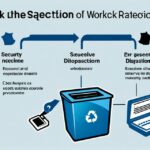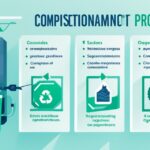Ensuring Security: The Practice of Desktop Secure Erasure
Data privacy and secure data removal are paramount concerns for organizations in today’s digital age. As technology advances and cyber threats evolve, it is crucial to adopt best practices for Desktop Secure Erasure. By effectively erasing data from devices, organizations can protect sensitive information, comply with data protection regulations, and safeguard their reputation. In this article, we will explore the importance of data erasure, the methods used for secure data erasure, and the best practices that organizations should implement.
Before we delve into the details, let’s briefly define what Desktop Secure Erasure entails. It refers to the process of permanently removing data from computers and other desktop devices, ensuring that it cannot be retrieved or accessed by unauthorized individuals. This practice is crucial, especially when devices are being repurposed, sold, or disposed of. Failing to properly erase data can result in serious data breaches, legal implications, and damage to an organization’s reputation.
Effective Desktop Secure Erasure involves a combination of technical processes and organizational policies. Organizations should develop a data retention and destruction policy, which outlines the procedures and timelines for securely erasing data. They should create an inventory of data-bearing devices to track their lifecycle and ensure all data is properly erased. The erasure process can be carried out onsite or offsite, depending on the organization’s resources and requirements.
Using certified data erasure software is crucial for secure data removal. This software ensures that data is overwritten with random patterns, making it virtually impossible to recover. It is recommended to use software that complies with international standards and regulations, such as the Blancco data erasure software.
Organizations should also provide data erasure training to their employees to ensure they understand the importance of secure data removal and follow the proper procedures. Regular audits should be conducted to verify and document the erasure process, providing evidence of compliance and due diligence.
By implementing these best practices, organizations can achieve secure desktop erasure, protecting sensitive information, enhancing data privacy, and mitigating the risks associated with data breaches. Let’s explore the importance of data erasure in the next section.
The Importance of Data Erasure
Data erasure plays a crucial role in safeguarding data privacy and preventing security breaches. Organizations must prioritize data erasure to comply with regulatory laws and avoid severe penalties for non-compliance. Failure to properly erase data can result in significant financial consequences and irreparable damage to a company’s reputation. Moreover, the repercussions of a data breach extend far beyond financial losses, as they can cause a loss of customer trust and have long-lasting negative effects on an organization.
Implementing secure data erasure practices is paramount to protect sensitive information and mitigate the risks associated with security breaches and non-compliance penalties. By removing all traces of data from storage devices, organizations can prevent unauthorized access and ensure the confidentiality, integrity, and availability of their valuable data. This not only safeguards their reputation but also fosters trust among customers, partners, and other stakeholders.
When sensitive data is not adequately erased, it remains vulnerable to unauthorized disclosure or misuse. Confidential customer information, intellectual property, trade secrets, and other valuable data can fall into the wrong hands, leading to severe consequences. In addition to legal repercussions, organizations may face substantial financial penalties for non-compliance with data protection regulations and privacy laws. These penalties serve as a deterrent, incentivizing organizations to implement robust data erasure practices.
Investing in secure data erasure solutions and following best practices ensures that organizations adhere to regulatory requirements, such as the General Data Protection Regulation (GDPR), the California Consumer Privacy Act (CCPA), and industry-specific data protection standards. By erasing data in a certified and auditable manner, organizations demonstrate their commitment to protecting customer privacy, reinforcing their compliance with applicable laws and regulations.
It is important to note that data erasure is not a one-time task. As technology evolves and new threats emerge, organizations must regularly review and update their data erasure policies and procedures. This includes staying informed about the latest techniques and tools available for secure data erasure and adopting them accordingly. By prioritizing data erasure, organizations can proactively address potential security risks, protect data privacy, and ensure regulatory compliance.
Methods for Secure Data Erasure
When it comes to securely erasing data from devices, there are various methods available, each with its own advantages and considerations. These methods include software-based methods, hardware-based methods, and hybrid methods that combine both software and hardware techniques.
Software-Based Methods
Software-based methods involve using specialized data wiping software to overwrite the existing data on the device with random patterns. This process ensures that the original data is permanently removed and cannot be recovered. Data wiping software is designed to comply with industry standards and provides secure erasure algorithms to safeguard sensitive information.
Hardware-Based Methods
Hardware-based methods, on the other hand, involve physically destroying the storage device to prevent any potential data recovery. This method is commonly used for devices that cannot be effectively wiped using software-based methods, such as damaged or malfunctioning devices. Physical destruction ensures that the data stored on the device is completely irretrievable.
Hybrid Methods
Hybrid methods combine the use of software-based and hardware-based techniques for data erasure. This approach offers a comprehensive and robust solution to securely erase data. By utilizing both software and hardware methods, organizations can achieve a higher level of security and ensure the complete removal of sensitive information.
The choice of method depends on various factors, including the required level of security, the type of data being erased, and the available resources. It is essential to back up important data before initiating the erasure process and use certified data erasure software to ensure compliance with industry standards. Organizations should also follow proper procedures for erasing data from different types of devices to maximize the effectiveness of the chosen method.
By employing software-based, hardware-based, or hybrid methods, organizations can confidently safeguard sensitive information and maintain data privacy. Failing to implement proper data erasure methods can result in potential security breaches and regulatory non-compliance, leading to severe consequences. The appropriate method must be carefully selected and executed to ensure the permanent removal of data from devices.
| Method | Advantages | Considerations |
|---|---|---|
| Software-Based |
|
|
| Hardware-Based |
|
|
| Hybrid |
|
|
Best Practices for Data Erasure
When it comes to data erasure, following best practices is essential to ensure the secure removal of sensitive information. Implementing these practices not only protects data privacy but also helps organizations comply with regulations and mitigate the risks of unauthorized access or data breaches. Here are some key best practices to consider:
-
Conduct a Data Inventory:
Before initiating the erasure process, it is crucial to perform a comprehensive data inventory. This inventory helps identify all data-bearing devices within the organization and ensures that no important data is accidentally erased.
-
Implement a Backup and Recovery Plan:
Having a backup and recovery plan in place is essential to mitigate any issues that may arise during the erasure process. This plan ensures that critical data is securely backed up and can be recovered if needed.
-
Establish a Data Destruction Policy:
A data destruction policy provides clear guidelines for erasing all sensitive data. It outlines the procedures, tools, and methods to be used for erasure, ensuring consistency and compliance across the organization.
-
Verify Data Erasure:
Verifying data erasure is a crucial step to ensure that the data has been completely and securely removed. Regularly test and validate the effectiveness of the erasure process to minimize the risk of data remnants.
-
Use Effective Erasure Methods:
Employing effective erasure methods is key to achieving secure data removal. Methods such as overwriting data multiple times with random patterns are recommended to ensure that the original data is irretrievable.
-
Document the Erasure Process:
Documenting the erasure process is important for future reference and audit purposes. It helps track and demonstrate compliance with data protection regulations and can be used as evidence of due diligence.
To further illustrate the importance of these best practices, here is a table summarizing the benefits of each practice:
| Best Practice | Benefits |
|---|---|
| Conduct a Data Inventory | Prevents accidental erasure of important data |
| Implement a Backup and Recovery Plan | Mitigates issues during the erasure process |
| Establish a Data Destruction Policy | Ensures consistency and compliance |
| Verify Data Erasure | Confirms complete and secure data removal |
| Use Effective Erasure Methods | Ensures irretrievability of the original data |
| Document the Erasure Process | Demonstrates compliance and provides audit trail |
By following these best practices, organizations can effectively safeguard sensitive data, protect against data breaches, and maintain data privacy. Implementing a comprehensive data erasure strategy is necessary for any organization that prioritizes security and regulatory compliance.
Conclusion
Data erasure is a critical practice for organizations to ensure the secure removal of sensitive information and protect data privacy. Implementing best practices for data erasure is essential to prevent data breaches, comply with regulatory requirements, and safeguard reputation. By choosing the appropriate erasure method, verifying the effectiveness of the erasure process, and properly disposing of IT equipment, organizations can mitigate the risks associated with data breaches and protect against potential security breaches.
Organizations must prioritize data privacy and take proactive measures to securely remove data. By following industry-approved methods and using certified data erasure software, the risk of unauthorized access to sensitive information can be significantly reduced. It is crucial to address the challenges of data protection and remain vigilant against emerging threats.
Additionally, organizations should consistently review and update their data erasure policies to align with changing regulations and technological advancements. Regular audits and documentation of the erasure process provide an additional layer of protection, ensuring compliance and accountability. By adopting a comprehensive approach to data erasure, organizations can maintain trust, protect valuable assets, and enhance data security.
FAQ
Why is data erasure important for organizations?
Data erasure is crucial for organizations to protect sensitive information, comply with data protection regulations, and safeguard their reputation and data integrity.
What can happen if data is not properly erased?
Failure to properly erase data can result in hefty fines, legal implications, loss of customer trust, and long-lasting negative effects on a company’s reputation.
What are the different methods available for securely erasing data?
There are software-based methods that use specialized software, hardware-based methods that involve physically destroying the storage device, and hybrid methods that combine software and hardware-based techniques.
What should organizations do before erasing data?
Before erasing data, organizations should conduct a data inventory, have a backup and recovery plan in place, and establish a data destruction policy with clear guidelines for erasing sensitive data.
How can organizations verify the effectiveness of data erasure?
Organizations can verify data erasure by using effective methods, such as overwriting data multiple times with random patterns, and by documenting the erasure process for future reference.
Why is data erasure important for data privacy and protection against breaches?
Data erasure helps prevent unauthorized access to sensitive data, mitigates the risks associated with data breaches, and ensures compliance with regulatory requirements.















